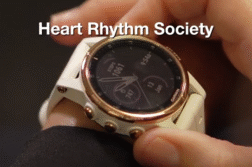LOS ANGELES, Ca. (Ivanhoe Newswire)— No matter race or gender, heart disease is the leading cause of death for Americans. In fact, one person dies every 36 seconds from cardiovascular disease and many of them don’t even know they have it. The key to survival is early detection and treatment. And now, doctors say the earliest warning signs may not be found by your cardiologist but by your ophthalmologist.
Your next trip to the eye doctor may reveal much more than whether you’re nearsighted or farsighted.
“It’s like a window to our health,” Mathieu Bakhoum, MD, PhD, a former retina surgeon at UC San Diego Health, told Ivanhoe.
“The eye is an organ, which often is the first sign of cardiovascular disease,” Anthony DeMaria, MD, a cardiologist at UC San Diego Health, shared.
Cardiologists and ophthalmologists are working together to prove the eyes are truly a window to your heart.
Already used by eye docs to image the retina, now an optical coherence tomography scan, or OCT, can reveal even more.
Dr. Bakhoum stated, “The near infrared signal is able to penetrate through the cornea and to the retina.”
“Which is like creating a slice of the retina and looking inside,” Dr. DeMaria noted.
Decreased blood flow caused by heart disease may cause cells in the retina to die, leaving behind permanent marks called RIPLs.
“We called it RIPL because it’s wavy. And also, because it’s usually around the vessels,” Dr. Bakhoum elaborated.
A new study revealed that individuals with RIPLs in one or both eyes had a higher chance of developing cardiovascular disease.
Dr. DeMaria exclaimed, “The most exciting part of this technology is that the potential exists for a finding in the eye to indicate the presence of disease in the heart.”
Enabling doctors to begin early therapy and reduce the chances of suffering a heart attack or stroke.
RIPLs are permanent. They do not go away over time, and they do not impact your eyesight. Although multiple RIPLs are a tale-tell sign of heart disease, not all people diagnosed with heart disease will have RIPLs.
Contributors to this news report include: Marsha Lewis, Producer; Roque Correa, Videographer; Roque Correa, Editor.
To receive a free weekly e-mail on medical breakthroughs from Ivanhoe, sign up at: http://www.ivanhoe.com/ftk
Source:
MEDICAL BREAKTHROUGHS
RESEARCH SUMMARY
TOPIC: DETECTING HEART DISEASE IN YOUR EYES: MEDICINE’S NEXT BIG
THING?
REPORT: MB #4953
BACKGROUND: Heart disease describes a range of conditions. A buildup of fatty plaques in arteries, or atherosclerosis can damage blood vessels and the heart. Plaque buildup causes narrowed or blocked blood vessels that can lead to a heart attack, chest pain (angina) or stroke. Coronary artery disease symptoms may be different for men and women. For instance, men are more likely to have chest pain. Women are more likely to have other signs and symptoms along with chest discomfort, such as shortness of breath, nausea, and extreme fatigue.
(Source: https://www.mayoclinic.org/diseases-conditions/heart-disease/symptoms-causes/syc-20353118)
DIAGNOSING: Most eye exams include an inspection of the outside and inside of the eye. An ophthalmologist will use an ophthalmoscope to examine things such as pupil reflexes, the lens of the eye, the retina, and the optic nerve. Hypertension isn’t the only heart-related ailment that can be detected in the eye. “If we see small emboli in the eye, they can be coming either from an arteriosclerotic plaque in the carotid artery, which is the main artery that brings blood to the head and neck, or they can come from emboli in the heart,” Dimitra Skondra, M.D., Ph.D., said. An arterial embolism occurs when an embolus has travelled through the arteries and become stuck in small vessels or organs like the brain or the retina. This can either restrict or block blood flow, which can result in tissue damage, a stroke, blindness or even death.
NEW TECHNOLOGY: In a new study from Shiley Eye Institute at UC San Diego Health, researchers have identified a potential new marker that shows cardiovascular disease may be present in a patient using an optical coherence tomography (OCT) scan, a non-invasive diagnostic tool commonly used in ophthalmology and optometry clinics to create images of the retina. The finding suggests it may be possible to detect heart disease during an eye examination. The research team examined lesions of the retina, the innermost, light-sensitive layer of the eye, to determine if a cardiovascular disorder may be present.
(Source: https://ucsdnews.ucsd.edu/pressrelease/heart-disease-is-in-the-eye-of-the-beholder)
FOR MORE INFORMATION ON THIS REPORT, PLEASE CONTACT:
JEANNA VAZQUEZ
858-249-0428
If this story or any other Ivanhoe story has impacted your life or prompted you or someone you know to seek or change treatments, please let us know by contacting Marjorie Bekaert Thomas at mthomas@ivanhoe.com




